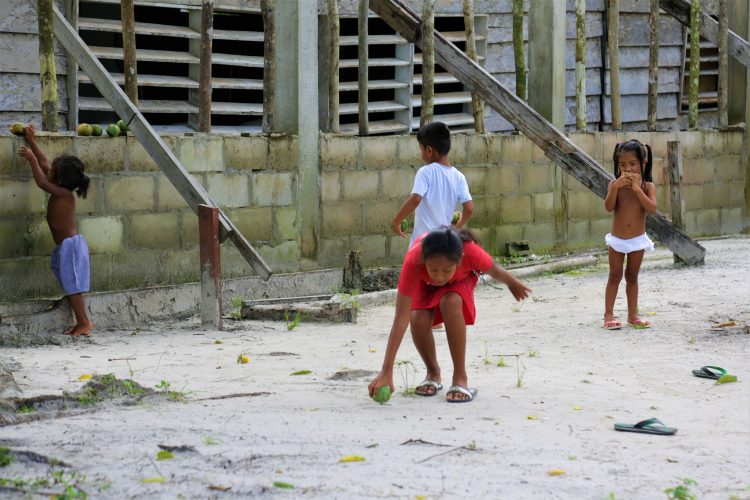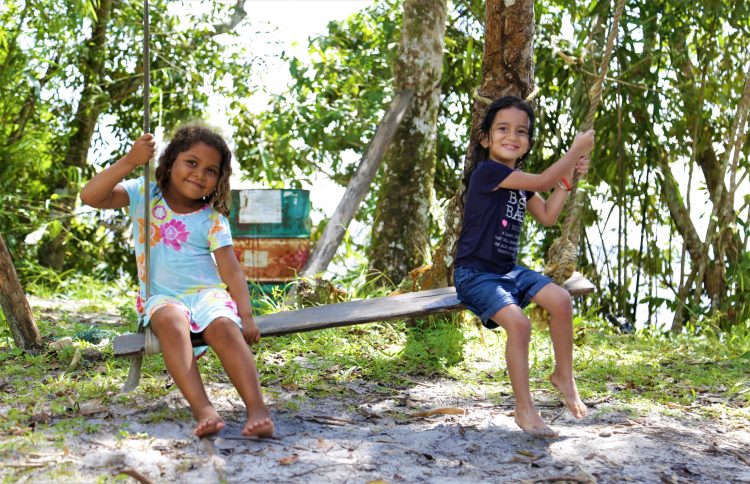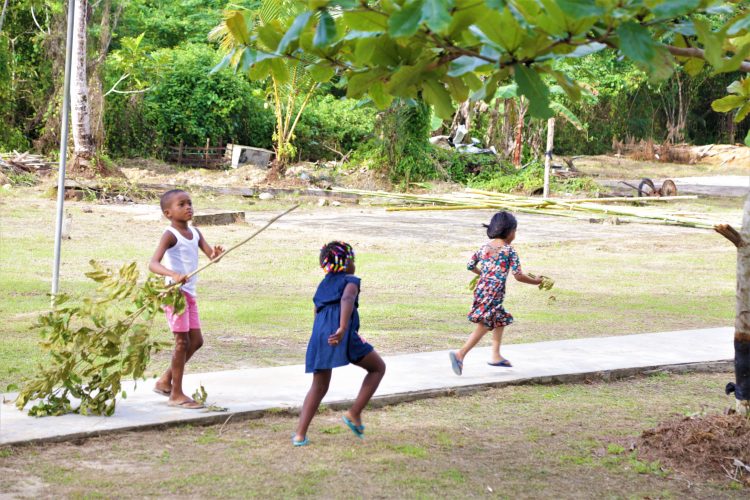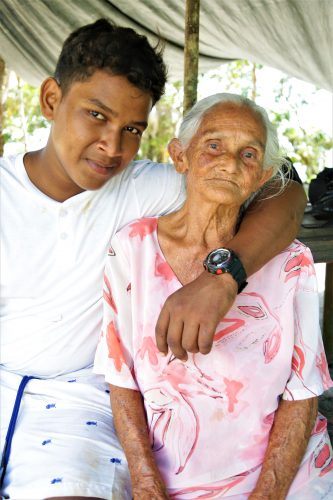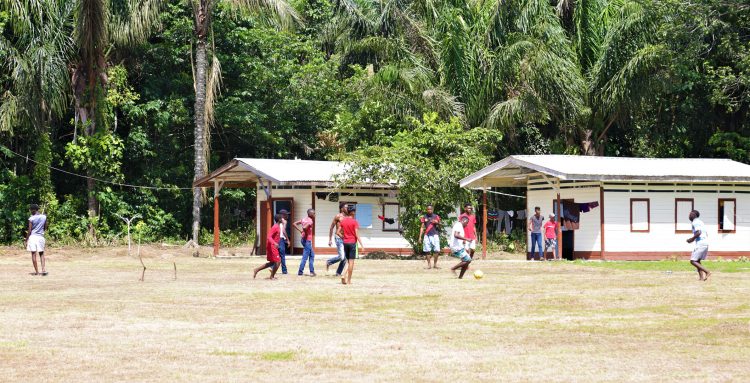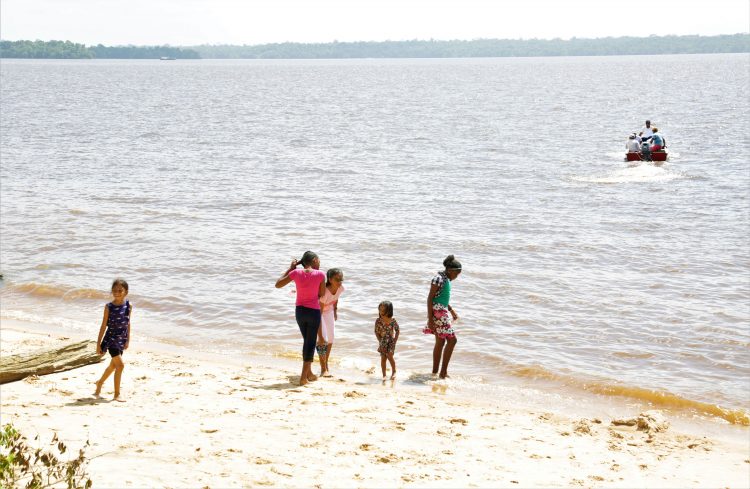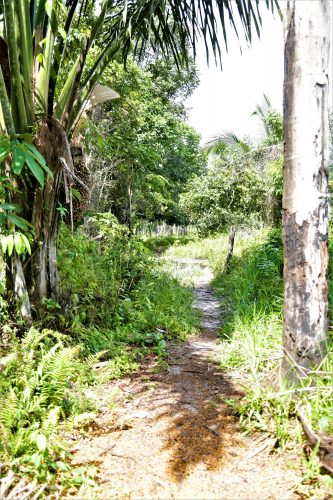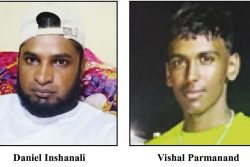Goshen, a satellite community of River’s View Village, is situated in Region 10 (Upper Demerara-Berbice), though it is across the Essequibo River from Bartica, which is in Region 7 (Cuyuni-Mazaruni). Home to no more than 100 residents and curious jungle cats, Goshen is also a popular camping ground for several churches.
To get to Goshen, I took a speedboat from Parika that was destined for Bartica. The speedboats usually stop at Goshen and other villages along the route to drop off passengers. Goshen is some 10 to 15 minutes from Bartica and when the speedboat got there the tide was too low for it to stop at the stelling. I was among the few passengers who were forced to jump from the bow of the boat onto the beach to joyful shrieks from children and members of the Church of the Nazarene who were using the Baptist Church campsite. Some of the folks stood under the giant trees enjoying the view of the Essequibo River while keeping their eyes on the children playing on the beach. Nearby, three boys were up a mango tree tossing down fruit to others standing below.
Auntie Carmen’s story
Kenneth Edwards, Toshao of Goshen and its neighbouring villages, lives in River’s View but during a telephone conversation had given me the names of some persons to visit. Carmen Williams was the first.
The woman, whom everyone in Goshen calls Auntie Carmen, was seated near her son who was enjoying a meal of cook-up rice and barbecue chicken, while her granddaughter turned pieces of chicken and beef on a grill. They were all under a tree.
Asked how old she was, since she had been referred to as one of the oldest in the village, Auntie Carmen set the record straight: “Oh, I’m a little girl; just 80 years young,” she joked.
Born in Georgetown, Auntie Carmen moved to Goshen with her family when she was three months old. Some years later, when her mother died, she was moved from one foster family to another. She had her father and a brother, but it was felt that she needed the care of a woman so residents in the village took her in. They saw that she got her schooling, which she did at the Holy Name Anglican School.
“The people I stayed with the longest lived next to the Baptist Church. They were the Richardsons,” Auntie Carmen recalled. “The lady she send me to school. They had two children. The ole lady was a very strict ole lady; you can’t play too long. I tell me children them, I know what is work. From 4 o’clock in the morning you wake up, you got to bathe, you got to wet from you head to you foot. I tell them I learn to bake bread from 7 years; since then I know to cook. They never hungry me or naked me but work, work, work. I tell you; yes, you know what is work?”
Some of the families she remembers from back then are the Barkers, the Kaisers, the Hayneses, the Bacchuses, the Spencers and the Valens.
The Valens and the Spencers were her favourites. They treated her as one of their own children, she remembered. “I grow up with the Richardsons them and they know how the ole lady was strict. When you see the ole lady gone Bartica, by the time she back turn, they gon call: ‘Carmen, Carmen’, they clapping they hand, ‘Carmen, come quick, come’. Whatever they got, they share with you. If is enough, you carry home and you left fuh them,” she said.
“It had an ole lady at River’s View side not far from the captain (toshao); she did name Bowen. I does tell me children them, that the ole people them was very nice people. The young ones them come and they got the whole place in an uproar. Why? Drinking, smoking and them ain’t care what they get on with. That’s the young people them today. They could never match up to the ole people them. After I did get big, they [old people] will come and help you cut you farm and you will go back and help them cut and they will come back and help you burn and clean and is suh the people them on this shore used to live. Not today; everybody fuh themselves and if they got to move this pin and put it suh, you got to pay them to do it. Years ago, it wasn’t suh, everybody used to live happy, real happy.”
Villagers work in the mines, farm and fish for their livelihoods. Sometimes they can be seen with their arrows and bows seeking hymara (a freshwater fish). They also use their arrows and bows—and for a few of them, guns—to shoot wild hog, labba and deer for meat.
‘I accustom to moving’
Auntie Carmen recalled that the first church to set up camp at Goshen was the Seventh Day Adventist and that was in 1955. Soon after, Auntie Carmen was hired as a baker. “A bag of flour every day; you got to bake for 200 people. When you see yuh mix flour in the morning, you ain’t going home till after midnight. You got to bake out that whole bag of flour before you see home. I work with them from 1955 until I think 1968, when I retired from the camp.”
Goshen’s residents use the river water for bathing, doing their laundry and dishes. Rainwater is reserved for drinking and cooking. Auntie Carmen makes her way to the river for her baths every morning at six. Sometimes when it rains and the tide is high, she said, someone might spot an anaconda or a caiman and would alert others in the neighbouring villages to be careful in the river. Alerting each other to wildlife and strangers is a habit. Whenever there is a visitor in Goshen, villagers are informed.
Auntie Carmen still farms: “I like that the place is very quiet. You can go at the back there, you can cut a lil piece ah ground, you can shove something inside. The only thing that bothers me is the cushay [acushi] ants. All here where you plant you fruit trees them, they come and they cut it down. The only thing that they don’t cut is coconut trees, the cane and the pine but any other thing… they cut it down to nothing.
“I got a lil piece of bed. If I give up planting, you ain’t see I gon lie down in me bed. I got to continue doing something to help meself. I plant yam, cassava, eddo and sucka [banana or plantain]. I just praying everyday fuh leh cushay ain’t touch it. That’s the thing mek people don’t really cultivate this place.
“Sometimes I walk and visit my daughter in town. I tell she me don’t like go in town. I tell she you got me like a queen, I sit down deh suh whole day, ‘mommy don’t do nothing’; you gon wash, you gon cook and mommy gon sit down like a queen? Mommy ain’t accustom to that. I accustom to moving. Me nah custom to them thing. When me gon go in town and sit down like a queen now, what gon happen? You ain’t see is sick I gon tek down sick? Right now, ah praying fuh lil sunshine and leh me get to extend me lil piece of bed at the back fuh shove in some more thing inside the ground.”
Apart from the acushi ants, Auntie Carmen said, wild hogs and the acouris would sometimes destroy her farm. The wild hogs would pull out her cassava sticks and eat the “bearing” while the acouris would eat her cucumber plants. Asked whether the dogs would chase away the animals, the woman humorously said that the dogs her son is minding is for “mind sake”. She added that the dogs her late husband had were “hunting dogs” as they chased away most of the animals; except for the jaguars that tended to make a meal of them. Jaguars, she said, often roamed Goshen especially in the dry season. The last time one of them made off with one of her dogs was two years ago. However, villagers would see them from time to time. Her granddaughter, eavesdropping while at the barbecue grill, piped in to say that they would hear the cats at night. “Right here pon this reserve, it got people living at the back. When the night come and they going in, sometimes they turn back and telling we that tiger [jaguar] in the track,” Auntie Carmen said. “Sometimes them lil children going home and they running back and they hollering ‘tiger, tiger’. It ain’t safe. I tell me son already, you better apply for a gun. Them poor little children coming through the track and many times them big people going in at night and you know them ain’t fraid. All hour ah the night you see them people going inside there. They would strike the torchlight on them and they [the jaguars] would run away,” she said.
Reuben’s fate
This brought her to a chilling story, one she would always tell the children passing by so that they would stay alert. “Years ago, nearby the Anglican school that I went to, it had a road going till in suh at the Mokowra Creek. The two children they coming out to school: the girl was 14 and the boy was 12. The girl seh she go in the corner of a bush to ease she bowels. The boy now, he think it best to sit down in the lil track that they coming out in.
“When she finish deh and she come out, all she coulda holler and tell the boy ‘Rueben look ah tiger behind yuh’. By time she holler, the tiger jump on the boy. He got he books in he hand, he get up again and he start to run. Being she big more than he, she run away in front of he. The tiger tek off again with a speed behind he and box the boy on he foot, and the boy tumble. She seh it had a big tree, it didn’t fall flat on the ground, it did just root out. She run up into the tree and she watch and see when this tiger box the boy foot and when he done he come from the back and he bite the boy.
“I was in me 20s then. When I go and see this child after, it had two big holes in he neck, mussy way he sink in he teeth. I say, ‘Ow coming to school, watch what is the end ah yuh eh?’ The teacher seh when the girl meet to the school, this girl, white, white. He asking she what happen but the girl cyant talk. He guh and he bring wata fuh she and give she fuh drink. When she done drink the wata, he seh ‘what happen?’ She seh ‘sir, if ah tell yuh’. He seh ‘what?’ She seh ‘tiger kill Rueben’. School call off that day. All big children them and the big people them turn out and the police come from Bartica. Them tek trace where the tiger bite the boy and haul he. It had another big tree again that didn’t fall flat where tiger put the boy under. [And the body was removed.] So the tiger didn’t get to come back the night and eat the boy.
“I does warn these children who living at the back. I does tell them be careful. It got two lil girls who does come out here late to go to the shop. I does tell them hurry buy what ayo come out to buy and run in back. Ah seh ayo want dead like Rueben? Ayo cyant tell when that tiger set back fuh ayo because when you see them hungry they set back fuh anything at all. Ah does sorry fuh these poor little children when they got to come out, especially when the rain fall. When the rain fall, everything deh out.”
Auntie Carmen spoke of the older children attending secondary schools, noting that with no high school in the village, they all had to go by boat to the schools in Bartica. Rain sometimes hinders this and on some days they would be late or absent. Auntie Carmen wishes there was a high school in Goshen.
It is her hope also that the jungle can be cleared around where residents live. She said that for years both administrations have been talking about building a road from Parika to Goshen. In April, Public Infrastructure Minister David Patterson said that a feasibility study for the Parika to Goshen all-weather road had been completed and they were seeking a public-private partnership to do the road. (To be continued next week)

